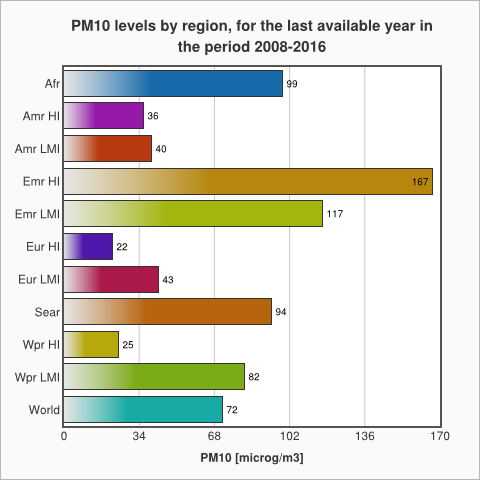More than 90% of the global population is breathing dangerous levels of air pollution, according to the latest report on air quality by the World Health Organization, and India in particular has become the epicenter of disease-inducing air.
In fact, the country has the 14 most polluted cities in the world.
All across the world, levels of fine particulate matter — indicating the presence of sulfate, nitrates, black carbon, and other contaminants — exceed levels deemed safe by WHO.
Take Action: Call on Governments and Business Leaders to Say No to Single-Use Plastics
And this rampant pollution is prematurely killing 7 million people each year, according to WHO. As fine particles from pollutants fill the air, they penetrate the lungs and cause “stroke, heart disease, lung cancer, chronic obstructive pulmonary diseases and respiratory infections, including pneumonia,” WHO notes.
More than 90% of these deaths occur in “low- and middle-income countries, mainly in Asia and Africa, followed by low- and middle-income countries of the Eastern Mediterranean region, Europe and the Americas.”
The report is the most comprehensive to date, collecting information from 4,300 cities in 108 countries.

“Many of the world’s megacities exceed WHO’s guideline levels for air quality by more than 5 times, representing a major risk to people’s health,” Dr. Maria Neira, director of the department of public health, social and environmental determinants of health at WHO, said in a press release.
Read More: You’re Probably Breathing Polluted Air, Study Finds
Scanning the WHO database, an unsettling disparity emerges, with some countries exhibiting astronomic levels of pollution and others within relatively safe bounds.
In the US, for example, most cities have relatively mild particulate matter levels. The most polluted city in the US is Hanford, Washington, with 36 particles under 10 micrometers (PM10) per one million particles and 18 particles under 2.5 (PM2.5) micrometers per one million particles.
The WHO recommends that PM10 levels should be kept under 20 and PM2.5 levels be under 10.
Read More: 5 Obscure Pollutants That Are Ruining the Planet
In India, particulate matter levels are regularly 10 to 20 times higher than the recommended threshold. The most polluted city in India is Varanasi, which in one area has PM10 levels of 416, and PM25 levels of 217.
The WHO says that the major sources of pollution in the world are coal-fired power plants, transportation and agriculture sectors, deforestation, and waste burning, among other sources.
The easiest way to reduce air pollution is to limit these practices.
But while the overall numbers are grim, the WHO is optimistic about the power of transparency.
“It hurts India’s image, hurts the India story, hurts tourism, hurts medical tourism,” an Indian official told Dawn, in reference to the WHO report.
Read More: These Are the Most Polluted Places in the UK
“India will eventually overcome the problem, but my frustration is with the timeline,” he added.
Other countries have benefitted from transparency.
China, for example, has air pollution after reports on dangerous air quality triggered mass protests.
Beijing, once the epitome of smog-filled skylines, has brought PM10 levels from above 300 in 2014 to around 100 on average as of the latest WHO readings.
“Political leaders at all levels of government, including city mayors, are now starting to pay attention and take action,” adds Dr. Tedros. “The good news is that we are seeing more and more governments increasing commitments to monitor and reduce air pollution as well as more global action from the health sector and other sectors like transport, housing and energy.”
Global Citizen campaigns on the United Nations’ Global Goals, which call on countries to provide a clean, healthy environment for all people. You can take action on this issue here.